Durum agronomy a northern perspective
Author: Rick Graham, Guy McMullen, Steven Simpfendorfer, Stephen Morphett and Neroli Graham (NSW DPI) | Date: 23 Feb 2016
Take home messages
- Durum varieties (Caparoi, DBA Aurora, DBA Lillaroi and Jandaroi) displayed differential grain quality and yield responses to time of sowing and N management. Increased screenings (>5%) were the most common cause of quality downgrades.
- DBA Aurora appears to have a good yield potential, but has a tendency towards smaller grain size and an increased risk of screenings with increasing rates of nitrogen (N) application at sowing or when applied prior to stem elongation (GS31). It also appears to have the potential for lower grain protein content (GPC) due to yield dilution under high yielding situations.
- A strategy involving a split application of N at sowing and either GS31 or GS39, may reduce the potential for screenings in DBA Aurora whilst maintaining satisfactory GPC.
- DBA Lillaroi appears to maintain good grain stability (plumpness/reduced screenings) with increasing rates of N application and has improved grain size relative to Caparoi, DBA Aurora,and Jandaroi.DBA Lillaroi offers improved flexibility in terms of agronomic management (G x E x M).
- Sowing an appropriate maturity type durum in the early part of its optimum sowing window will generally maximise yield potential and reduce the extent of yield loss from crown rot (CR).
- Due to the increased susceptibility of durum crops to CR production needs to be targeted at low risk paddocks based either on stubble or DNA testing (PreDicta B®).
Background
Durum wheat (Triticum turgidum) production is generally targeted at high yielding environments with the potential to achieve grain protein content (GPC) of 13% and above. In northern NSW and QLD, most durum is received by grain handlers, and needs to meet Grain Trade Australia (GTA) quality receival standards. Only varieties receiving a Wheat Quality Australia (WQA) classification can be delivered to receive Australian Premium Durum (ADR) grades other than feed (Sissons 2014). Price downgrades are generally associated with decreasing GPC and grain plumpness (screenings), with the lowest quality durum (DR3) accepted for semolina and pasta production having a minimum 10% GPC with a maximum of 10% screenings. Importantly, GPC is a primary receival standard for which growers are paid, and significant differential premiums are offered for high grain protein levels.
The most common cause for grain quality receival downgrading in newer cultivars, has generally been due to screenings > 5% and GPC below 13% (Anon, 2014). The concerns for export markets have been the need to improve consistency of supply of DR1 and DR2 grade durum, and to maintain the high quality standards of Australian durum wheat. For GrainCorp, one of the main traders of northern durum, the market is essentially Italy, ex Newcastle terminal preferably meeting DR1 quality specifications, with DR2 (minimum 11.5% GPC and a maximum of 5% screenings) generally less desirable (GrainCorp pers. Comm.). For the major northern durum traders such as Cargill and GrainCorp, their emphasis is on maximising brand advantage and penetration of Australian durum into the Italian market.
The perceived risks associated with quality downgrading, as well as the potential impact that crown rot caused by the stubble borne fungus Fusarium pseudograminearum (Fp) has on production (Kneipp 2008), have been major constraints to expansion of the northern durum industry. Durum wheat is very susceptible to crown rot infection and losses can exceed 60% in years when moisture stress occurs during grain filling (Daniel and Simpfendorfer 2008).
What did we investigate?
A series of nitrogen (N) management, time of sowing (ToS) and crown rot management trials are outlined in this paper. The aim of these experiments are to contribute to the development of variety specific and tactical agronomy guidelines, for both new and existing durum varieties, so as to optimise variety adoption, yield and quality potential. This is particularly relevant, given the recent release of two new durum varieties, DBA Aurora (tested as UAD0951096), from the University of Adelaide and GRDC co-funded Southern Durum breeding program, and DBA Lillaroi (tested as 241046) from the co-funded GRDC and NSW DPI Northern Durum breeding program based out of Tamworth in northern NSW.
Results
Initial investigations - 2014
Preliminary experiments looking at durum variety response to N management at Tamarang on the Liverpool Plains and variety response to ToS at Narrabri on the lower Namoi, were undertaken in 2014 as part of the GRDC co-funded Variety Specific Agronomy Packages (VSAP) project (DAN 00167).
Durum wheat variety response to N management – Tamarang 2014
The aim of the experiment at Tamarang on the Liverpool Plains was to achieve protein targets for durum in a high yield potential environment, and to establish whether variety differences exist as a result of N management strategies.
The experiment included four durum cultivars, three commercially released varieties Caparoi, DBA Aurora and DBA Lillaroi as well as an advanced line from the Northern Durum breeding program 290564, in a fully replicated, factorial design with six N treatments in total. N treatments were 0, 20, 40, 80, 160 kg N/ha at sowing, and a 2 x 40 kg N/ha split application (at sowing: GS31) all applied as urea (46% N). N treatments were side banded at sowing with the split application broadcast at GS31.
Starting soil N levels (~160 kg/ha of available nitrate N 0-120 cm) were sufficient to optimise yield potential, with 11.5% GPC achieved at the nil N rate, increasing rates of applied N provided no grain yield benefit. In contrast, there was a GPC response for applied N, with GPC increasing with increasing rates of N application, with the critical GPC of 13% (DR1) achieved at > 80 kg of applied N, with no significant difference between varieties evident in this trial (data not shown). There was however, a significant variety response, with DBA Lillaroi achieving a grain yield advantage over the other durum entries and DBA Aurora being the lowest yielding variety in this trial (Table 1).
Table 1. Mean varietal grain yield (t/ha), grain protein concentration (GPC; %), grain nitrogen yield (GNY; kg N/ha), test weight (hL/kg), screenings (%), and thousand grain weight (TGW; g) averaged across N treatments
|
Variety |
Grain Yield (t/ha) |
Grain Protein (%) |
Grain N Yield (kg N/ha) |
Test Wt (g) |
Screening (%) |
TGW (g) |
|
DBA Lillaroi |
6.22 |
12.8 |
138.3 |
80.8 |
1.3 |
42.5 |
|
290564 |
6.03 |
12.7 |
134.4 |
81.7 |
3.4 |
36.9 |
|
Caparoi |
5.93 |
12.4 |
128.6 |
82.4 |
2.1 |
39.2 |
|
DBA Aurora |
5.63 |
12.4 |
120.8 |
79.6 |
6.5 |
35.1 |
|
lsd (P = 0.05) |
0.11 |
0.5 |
5.3 |
0.5 |
0.4 |
1.4 |
Importantly, results from this experiment found that the level of screenings was significant (P<0.001) with a variety, N rate and a variety by N rate interaction. Increased screenings were generally associated with higher rates of N application. The newly released variety DBA Aurora appeared to have difficulty achieving DR1 screening specifications of < 5% and was adversely affected by increasing rates of N application (Figure 1). In contrast, Caparoi and DBA Lillaroi were able to maintain good grain plumpness, achieving low screenings (<5%) across N application rates (Figure 1).
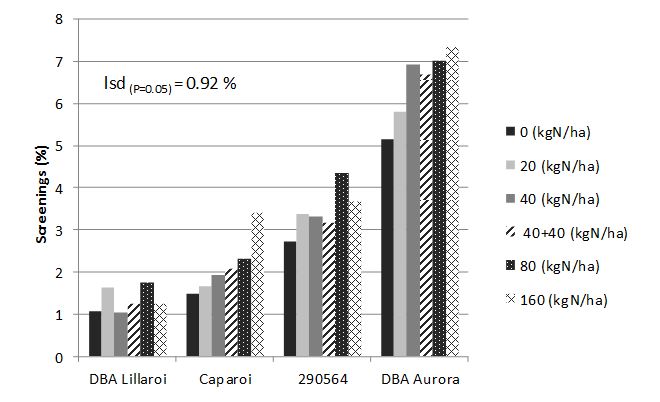
Figure 1. Effect of six nitrogen rates on screenings (%) in four durum varieties at Tamarang 2014
DBA Lillaroi exhibited excellent grain size (TGW of 42.5 g) and maintained lower screening levels in comparison to the other varieties including Caparoi (TGW 39.2 g) which is one of the larger grained durum varieties (Table 1). The relationship between grain size (TGW) and screenings averaged across N treatments is outlined in Figure 2, and illustrates the effect of grain size on potential risk of increased screenings.
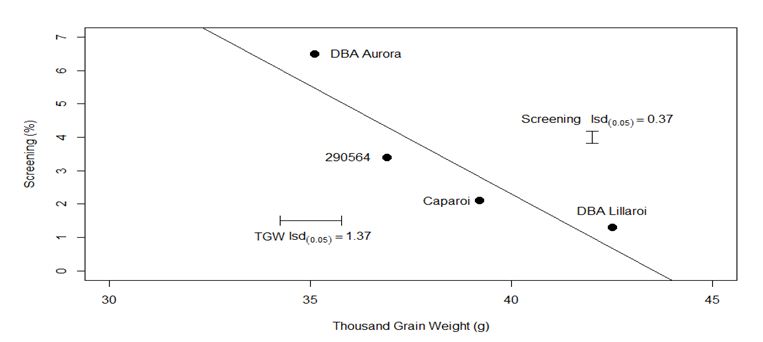
Figure 2. Relationship between screenings (%) and TGW (g) for four durum varieties averaged across nitrogen treatments -Tamarang 2014
In high yielding environments such as on the Liverpool Plains in 2014, with high starting N rates, from a late time of sowing (June 30) durum varieties were shown to have differential, grain quality responses. These preliminary findings from one site and season would indicate that DBA Aurora may have an increased risk of quality downgrading due to grain screenings when planted late in the sowing window. In contrast DBA Lillaroi due to its inherently larger seed size, reduced likelihood of screenings, and higher yield, appears to have a good fit in this environment, outperforming Caparoi in this trial. It would appear that growers should be cautious if considering planting DBA Aurora, if sowing is delayed particularly where there is potential (e.g. high starting N) for downgrading from increased levels of screenings.
Durum wheat variety response to four sowing dates – Narrabri 2014
A replicated time of sowing (ToS) experiment was conducted at the IA Watson Research Centre at Narrabri in 2014, to determine the grain yield and quality responses of 24 wheats (bread and durum), including a sub-set of three commercial durum varieties; Caparoi, DBA Aurora and DBA Lillaroi. The experiment was sown across four sowing dates of the 23rd April, 15th May, 12th June and 4th July, in a split plot design with three replicates, and was conducted on a black vertosol with a high starting soil N value of 300 kg N/ha (0-120 cm).
Results from this experiment highlighted the importance of sowing the correct maturity type in the earlier part of the suggested sowing window. All three durum varieties experienced yield and or quality penalties with either early or delayed sowings. When sown on April 23, well before the earlier part of the optimum sowing window, the early-mid maturing variety DBA Lillaroi, experienced a 61% (3.36 t/ha) yield penalty compared to sowing on May 15 (Figure 3). The yield reduction associated with this early ToS 1 was most likely due to frost induced sterility. There was a -3.3°C frost event on August 12, which coincided with full head emergence and/or early anthesis for DBA Lillaroi (GS59 – GS61). Both Caparoi (~GS53 - GS55) and DBA Aurora (~GS55 - GS57) which were less advanced during this frost event also experienced yield losses of ~ 18% (1.00t/ha) and ~26% (1.37t/ha) respectively when sown on April 23 (Figure 3).
Optimum yields were achieved from ToS 2 on May 15, for all three varieties with no significant difference between entries. Progressive decreases in yield were experienced across varieties with later sowings on June 12 and July 4 (Figure 3). Yield reductions were associated with increased temperature and moisture stress during the grain filling period (30°C September 26 increasing to~35°C on October 5) with all varieties showing significant (P<0.001) yield reductions (Figure 3).
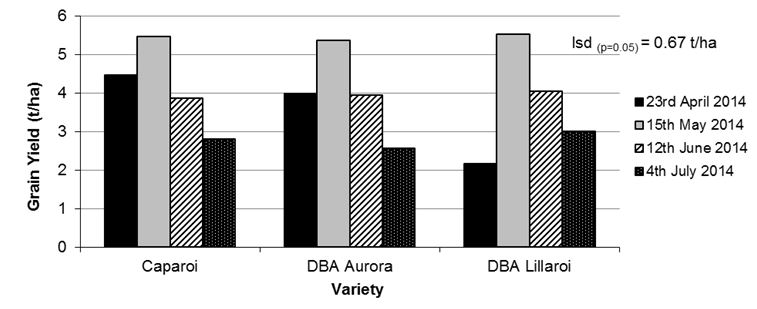
Figure 3. Grain yield response for three durum varieties across four sowing dates – Narrabri 2014
Importantly, apart from grain yield, quality parameters in particular screenings were impacted by a delayed sowing date, compounded by the high starting soil N level of 300 kg N/ha (0-120 cm) and the warm dry finish to the season. GPC and Test Weight (TWT) of all three varieties were within DR 1 specifications of > 13% GPC and >76kg/hl TWT across all times of sowing (data not shown).
In terms of screenings, Caparoi achieved DR1 specifications with ToS 1 and DR3 with ToS 2 and 3, but was outside specifications at 17.22% with ToS 4. DBA Aurora achieved DR3 with ToS 1 and ToS 2 but outside of specifications with ToS 3 and 4 with screenings of 11.64% and 22.28%, respectively. DBA Lillaroi achieved DR1 specifications with ToS 1 and made DR3 specifications with ToS 2, 3 and 4 (5.66% - 6.18% screenings) (Figure 4).
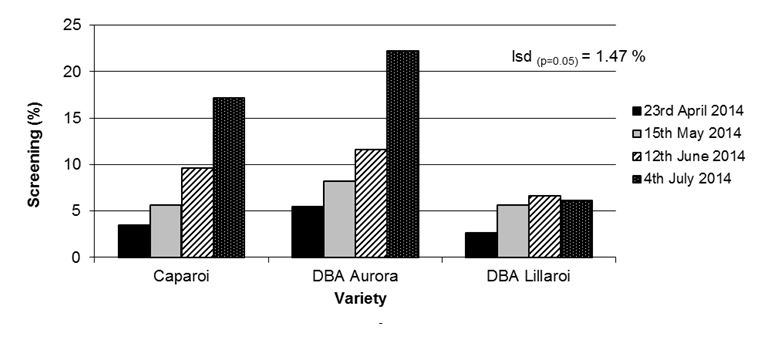
Figure 4. Effect of sowing date on screenings (%) for three durum varieties – Narrabri 2014
Results from this experiment indicate that DBA Lillaroi appears able to maintain grain stability (plumpness-reduced screenings) over a wide sowing window, with improved grain size (TGW) relative to Caparoi. DBA Lillaroi, however, was more exposed to frost risk on the earlier sowing time reinforcing the need to match maturity type to sowing time. DBA Aurora due to its increased risk of screenings and smaller grain size appeared less flexible when time of sowing is delayed outside of the early part of its optimum sowing window (ToS 2). From this ToS experiment, it would appear that DBA Lillaroi offers improved physical grain characteristics and comparable yield potential to both Caparoi and DBA Aurora in main season and later sowing opportunities.
What did we investigate - 2015
Based on the findings from the preliminary studies conducted in 2014, further ToS by N management experiments were undertaken in 2015, with a site at Tamarang on the Liverpool Plains and a second at Tulloona on the North West plains of NSW. In 2015, a replicated crown rot (CR) experiment (inoculated vs. uninoculated design) that included 5 durum wheat entries sown over two sowing dates was also conducted at Tulloona to examine the impact of CR and ToS on yield loss.
Durum wheat variety response to ToS and N management – Tamarang 2015
The aim of the experiment at Tamarang was to compare variety response to ToS and N management with the objective of developing variety recommendations and tactical agronomy guidelines, to increase the likelihood of varieties achieving DR1 and DR2 receival specifications, and to enhance variety adoption and improve yield and quality potential of new durum varieties.
The experiment included five durum wheat entries, four commercially released varieties Caparoi, DBA Aurora, DBA Lillaroi and Jandaroi, and an advanced breeder’s line from the Northern Durum breeding program 190873 in a fully replicated, factorial design with six N treatments in total. N treatments were 0, 40, 80, 120 and two split applications 2 x 40 kg N/ha either at sowing and GS31 or at sowing and GS39, all applied as urea (46% N). All treatments were side banded at sowing, apart from the split applications which had half applied at planting and half at stem elongation (GS31) or at flag leaf emergence (GS39)(total 80 kg N/ha). The trial was sown on two separate sowing dates (19th of May or 9th of July) in a split plot design with three replicates.
ToS 1 (May 19) was earlier than recommended for this region, with an earlier than ideal, but acceptable recommendation of the 4th week of May, for mid-season varieties e.g. Caparoi, and the 1st week of June for earlier maturing varieties namely Jandaroi (Matthews et al., 2015).
All varieties experienced a yield reduction with ToS 1 compared to ToS 2 (Table 2), due primarily to frost induced sterility/impact during grain fill. The earlier maturing varieties Jandaroi and DBA Lillaroi suffered the greatest yield losses of 1.51 t/ha and 1.64 t/ha, respectively in comparison to a yield loss of 0.89 t/ha and 0.82 t/ha for the later maturing varieties DBA Aurora and Caparoi when averaged across treatments and sowing times (Table 2).
Table 2. Mean varietal grain yield (t/ha) averaged across N treatments for two times of sowing - Tamarang 2015
|
Variety |
Yield ToS 1 (t/ha) |
Yield ToS 2 (t/ha) |
|
Caparoi |
5.35 |
6.17 |
|
190873 |
5.23 |
6.36 |
|
DBA Aurora |
5.11 |
6.00 |
|
DBA Lillaroi |
4.94 |
6.58 |
|
Jandaroi |
4.75 |
6.26 |
|
lsd (P = 0.05) ToS |
0.41 |
|
Grain quality parameters of screenings and to a lesser extent GPC were affected in ToS 1, with DBA Aurora and DBA Lillaroi downgraded to DR3 across all N treatments due to screenings >5%, with Caparoi only exceeding >5% screenings at the highest N rate of 120 kg N/ha (data not shown). The increase in screenings (ToS 1 vs. ToS 2) for DBA Lillaroi, was most likely due to a frost event during grain filling. Interestingly, the split application of N at GS39 did show a reduced trend in screenings for DBA Aurora.
ToS 2 sown on July 9, although sown later than preferred (outside the optimum sowing window) was still considered acceptable (Matthews et al., 2015). All varieties achieved significant (P<0.001) increases in grain yields over ToS1 (Table 2), with all varieties apart from DBA Aurora, achieving DR1 grain receival specifications. DBA Aurora was downgraded to DR3, due to screenings being > 5% across all N rates. When looking at variety response averaged across N treatments DBA Lillaroi achieved the highest TGW of 41.0 g, greater than both Jandaroi and Caparoi, with DBA Aurora at 33.0 g significantly lower than the other varieties (Table 3). The experimental line 190873, which has an ADR classification, performed comparable to commercially released northern varieties in terms of yield and grain quality specifications. As per ToS 1, there was no positive grain yield response to N application, with only a GPC response to increasing rates of N application (data not shown).
Table 3. Mean varietal grain yield (t/ha), grain protein concentration (GPC; %), grain nitrogen yield (GNY; kg N/ha), test weight (hL/kg), screenings (%), and thousand grain weight (TGW; g) averaged across N treatments ToS 2 (July 9th) – Tamarang 2015
|
Variety |
Yield (t/ha) |
Protein (%) |
Grain N Yield (kg N/ha) |
Test Wt (g) |
Screening (%) |
TGW (g) |
|
Caparoi |
6.17 |
13.8 |
150.2 |
84.7 |
4.0 |
36.0 |
|
190873 |
6.36 |
14.1 |
157.6 |
85.1 |
3.9 |
36.0 |
|
DBA Aurora |
6.00 |
13.5 |
142.6 |
82.9 |
7.9 |
33.0 |
|
DBA Lillaroi |
6.58 |
14.6 |
169.8 |
84.9 |
3.0 |
41.0 |
|
Jandaroi |
6.26 |
14.7 |
161.4 |
84.2 |
3.4 |
36.7 |
|
lsd (P = 0.05) |
0.22 |
0.2 |
8.5 |
0.5 |
0.5 |
1.2 |
The findings from this experiment highlight the need to sow varieties within their recommended sowing window for a given environment. An earlier than recommended sowing date of May 19 for the Liverpool Plains region, resulted in yield losses of ~25% averaged across N treatments for earlier maturing varieties such as Jandaroi and DBA Lillaroi, with possible grain quality implications also observed (e.g. increased screenings).
The most common cause of quality downgrades in this experiment was increased screenings >5%, with ~43% of variety x treatment combinations achieving grain quality specifications outside DR1 and DR2 in ToS1 with DBA Aurora also achieving > 5% screenings for all N rates in ToS2.
Durum wheat variety response to ToS and N management – Tulloona 2015
A ToS x N management experiment with varieties and N treatments as per the Tamarang trial was also conducted at Tulloona on the North West plains of NSW in 2015, with ToS 1 on 7th May 2015, and ToS 2 on the 6th June.
Results showed a variable variety response to the early ToS 1. The quicker maturing varieties Jandaroi and DBA Lillaroi suffered yield losses of 44% (2.5 t/ha) and 14% (0.75 t/ha), respectively averaged across N treatments, due most likely, to frost induced sterility from this early sowing date (Table 4). In contrast, the later maturing varieties DBA Aurora and Caparoi experienced yield increases of 19% (1.10 t/ha) and 7% (0.39 t/ha) over ToS 2, most likely the result of increasing temperature and moisture stress during grain fill in ToS 2 vs. ToS 1 (Table 4).
In contrast to grain yield, GPC showed a linear trend with increasing N rates, with no varietal interactions apparent. DBA Aurora failed to achieve DR2 specifications of >11.5% GPC for both the nil N treatments in ToS 1 and 2 and was outside DR1 specifications of > 13.0% GPC for all N treatments apart from ToS 2 with high upfront N rates of 80 to 120 kg N/ha (Figure 5). When looking at screenings, DBA Aurora was outside DR1 and DR2 specifications (< 5%) with all N treatments in ToS 1 and exceeded DR1 and DR2 specifications at 40, 80 and 120 kg N/ha upfront N treatments in ToS 2. The majority of other varieties were able to achieve DR1 and DR2 screening receival standards (data not shown).
Table 4. Mean varietal grain yield (t/ha) averaged across N treatments for two times of sowing - Tulloona 2015
|
Variety |
Yield ToS 1 (t/ha) |
Yield ToS 2 (t/ha) |
|
Caparoi |
5.68 |
5.29 |
|
190873 |
5.81 |
5.54 |
|
DBA Aurora |
6.89 |
5.79 |
|
DBA Lillaroi |
4.51 |
5.25 |
|
Jandaroi |
3.11 |
5.57 |
|
lsd (P = 0.05) ToS |
0.18 |
|
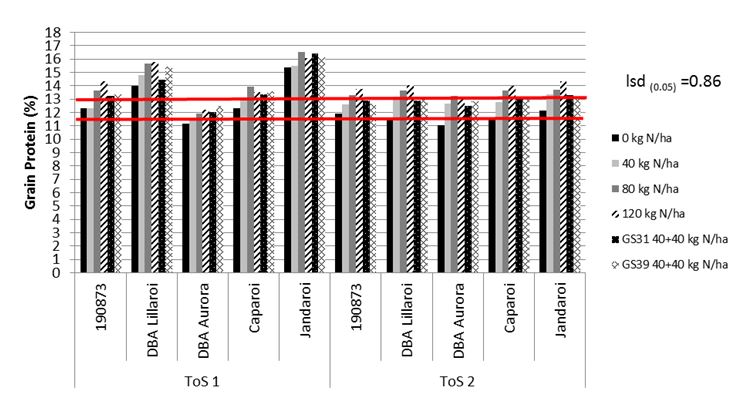
Figure 5. Effect of N management on GPC over two times of sowing – Tulloona 2015
It can be seen from this trial at Tulloona in 2015 that although DBA Aurora appears to have a high yield potential, it also appears to have an increased risk of quality downgrading due to screenings (>5%) particularly under sub-optimal finishing conditions (e.g. increasing temperature and moisture stress during grain fill) and or reduced GPC (<13%) due to yield dilution. When examining the influence of N management on screenings, it can be seen that with increasing upfront N application in ToS 2, that the percentage screenings increased in DBA Aurora (Figure 6). In contrast Caparoi, DBA Lillaroi and Jandaroi were able to maintain lower screening levels with increasing rates of N application. The results from this experiment did however indicate that a strategy involving a split application of N at either GS31 or GS39, may reduce the potential for screening issues in DBA Aurora whilst maintaining satisfactory GPC (Figure 6). The other varieties evaluated in this trial demonstrated relatively good grain stability and GPC across N rates.
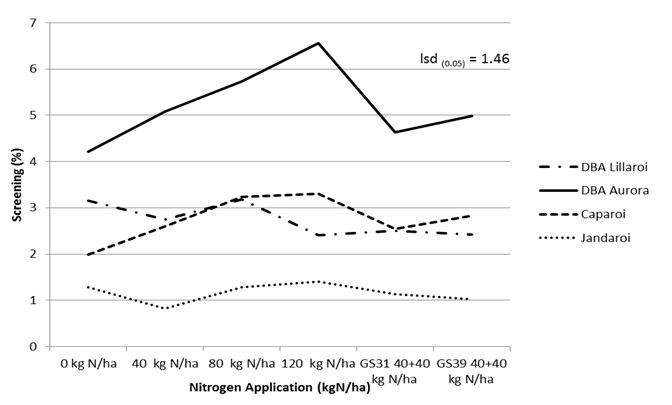
Figure 6. Effect of N management on screenings (%) of four durum varieties – ToS 2 Tulloona 2015
Impact of crown rot and sowing time on yield – Tulloona 2015
Ongoing evidence indicates that crown rot (CR) remains a constraint to the expansion of the northern durum industry and is a major reason for growers either moving away from or considering alternatives to growing durum. A replicated CR experiment (inoculated vs. uninoculated design) that included 5 durum wheats sown over two sowing dates (May 6th and June 4th) was conducted at Tulloona to examine the relative impact of CR and ToS on yield across durum entries.
Results from this experiment outlined in Graham et al. (2016) showed that all durum entries suffered significant yield losses in the presence of added CR, when ToS was delayed. Yield loss from added CR was not significant for any of the five durums in ToS 1. Importantly however, frost did significantly affect the yield potential of the quicker maturing durum varieties in ToS 1, with Jandaroi suffering a 2.8 t/ha or 60% decline in yield over ToS 2 (1.89 vs. 4.70 t/ha). All five durum entries; Caparoi, DBA Aurora, DBA Lillaroi, Jandaroi and the advanced breeding line 190873 suffered relatively high and significant yield loss in the presence of added CR with ToS 2. Losses ranged from 32% in line 190873 (1.4 t/ha) up to 35% in DBA Aurora (1.6 t/ha) with no significant difference (P<0.001) between entries.
Sowing date and variety selection per se is considered a balancing act between frost risk and early onset moisture/evaporative stress. Yield loss associated with crown rot infection is exacerbated by moisture stress during grain filling which restricts the ability of the plant to extract plant available water which negatively impacts on both yield and grain quality. Sowing an appropriate maturity type in the early part of its optimum sowing window will generally maximise yield potential and reduce the extent of yield loss from crown rot. However, given the potential yield loss associated with crown rot in susceptible cereal crops such as durum, there is a need to target production to low risk paddocks based either on stubble or DNA soil testing (PreDicta B).
Conclusions and implications
Results from this study indicate that durum varieties have different grain quality and yield responses to time of sowing and N management. DBA Aurora appears to have an increased probability of quality downgrading due to an increased risk of screenings/reduced grain plumpness, which appears to be related to its smaller grain size (TGW). This is more apparent when time of sowing is delayed and there is high starting soil and or upfront N application rates. DBA Aurora due principally to its increased risk of screenings would appear to offer less flexibility in terms of G x E x M to durum growers in northern NSW, in comparison to both Caparoi and DBA Lillaroi. Results did indicate that a strategy involving a split application of N at either GS31 or GS39, may reduce the potential for screenings in DBA Aurora whilst maintaining satisfactory GPC.
In contrast, DBA Lillaroi maintained grain stability (plumpness/reduced screenings) with increasing rates of N application and has improved grain size relative to Caparoi and Jandaroi. DBA Lillaroi appears to offer good plasticity in terms of agronomic management due to its ability to maintain grain size and achieve good GPC from upfront applications of N.
Given the export focus of the northern durum market, it is assumed that varieties with large plump grain that can more consistently achieve DR1 and DR2 specifications (~13% GPC and < 5% screenings) should continue to attract a premium and be preferred over varieties with an increased risk of quality downgrading. This will be particularly important while the emphasis remains on the consistency of supply in order to maximise brand advantage and penetration of Australian durum into premium export markets such as the EU.
Crown rot remains a limitation to the expansion of the northern durum industry due to the increased susceptibility of durum wheat to this disease. To help alleviate this constraint, durum crop production needs to be targeted to low risk paddocks based either on stubble or DNA testing (PreDicta B). Sowing an appropriate maturity type in the early part of its optimum sowing window will also generally assist in reducing the extent of yield loss associated with crown rot infection and maximise yield and grain quality potential.
References
Anon (2014). Durum quality and agronomy fact sheet (Southern Region), GRDC website
Daniel R, Simpfendorfer S. (2008). The impact of crown rot on winter cereal yields.
Graham R, Graham, N and Simpfendorfer S (2016). Yield impact of crown rot and sowing time on winter cereal crop and variety selection – Tulloona 2015. GRDC Updates, Coonabarabran 23-24 February, 2016.
Kneipp, J (2008). Durum wheat production accessed 3 January, 2016
Matthews PW, McCaffery D W Jenkins L (2015). Winter Crop Variety Sowing Guide 2015. New South Wales Department of Trade and Investment, Regional Infrastructure and Services.
Sissons M (2014). Durum wheat – current market quality requirements and opportunities, AEGI forum, Narrabri 19th March 2014. Online accessed 21 January, 2016
Acknowledgements
This project was co-funded by NSW DPI and GRDC under the Variety Specific Agronomy Project (DAN00167) and National Crown Rot Management and Epidemiology Project (DAN00175). Thanks to David Ronald, Jack Gooderham, Richard Heath (University of Sydney PBI Narrabri) for providing the trial sites. Thanks to Jim Perfrement, Peter Formann, Michael Dal Santo and Rod Bambach for sowing, maintaining and harvesting trials and Jan Hosking and Bruce Haigh for data collection and sample processing. The authors also acknowledge Dr Mike Sissons for his contributions to this paper.
Contact details
Rick Graham
NSW DPI, Tamworth
Ph: 0428 264971
Email: rick.graham@dpi.nsw.gov.au
Varieties displaying this symbol beside them are protected under the Plant Breeders Rights Act 1994
Was this page helpful?
YOUR FEEDBACK
